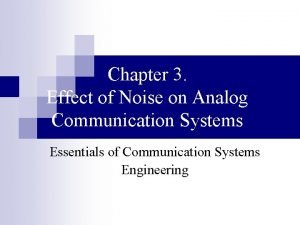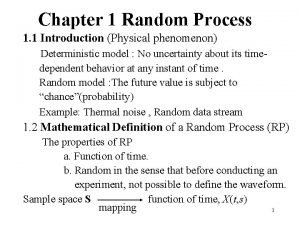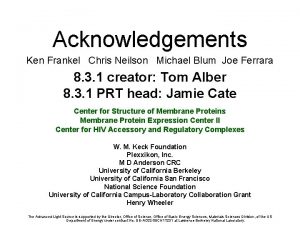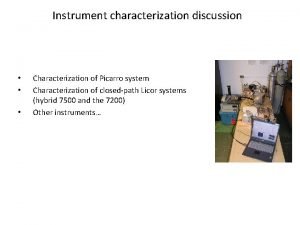Equipment Noise Characterization Desired Signal Thermal Noise Contained










- Slides: 10

Equipment Noise Characterization Desired Signal Thermal Noise Contained within bandwidth “B” Ideal Components NTH(W) = k. TB Ps(W) B G 1 GN

Noise Ratio PS 1(m. W) + NTH(m. W) G 1 + G 1(PS 1(m. W) + NTH(m. W) + N 1(m. W) Definition: A measure of how much a system degrades SNR. If NR is given, then we can compute Ratio of noise added to thermal noise (KT 0 B) T 0 is ALWAYS 290 K for Noise Ratio Computations

Equipment Noise Characterization Desired Signal Thermal Noise Practical Components Noise spectral density out of any device can never be less than k. T. NTH(d. Bm) = 10 log 10(k. T 0 B) + 30 d. B PS 0(d. Bm) B L 1(d. B) Because k. TB is in Watts! G 1 + + N 1(d. Bm) Shot noise contribution of first amp. We model the noise contribution as being added at the amp input, and amplified by the amp’s gain. Since noise power is being added, we must use m. W, NOT d. Bm.

Cascade Noise Ratio G 1 , NR 1 + + + N 1 G 1(PS 1 + k. T 0 B+ N 1) G 2 , NR 2 + N 2 G 2(G 1(PS 1 + k. T 0 B + N 1)+N 2) Which can be Generalized to N Stages: Friis’ Formula

Noise Ratio with Preceding Insertion Loss B L 1(d. B) G 1 , NR 1 + + N 1(d. Bm) a 1 PS 1 + k. T 0 B G 1(a 1 PS 1 + k. T 0 B + N 1) Since the effects of preceding loss are multiplicative w. r. t. both noise ratio and gain, it makes sense to deal with losses using d. B units. . .

Noise Figure (d. B) Noise Figure, NF(d. B), is Noise Ratio expressed in d. B: Noise characteristics for devices are usually published/specified by Noise Figure (d. B). When a device with specified Gain and Noise Figure (GI , NFI ; both in d. B) is preceded by one or more passive devices with specified total insertion loss (LI in d. B), they can be combined into a single stage having GC(d. B) = GI(d. B) – LI(d. B) LI GI , NFI and NFC(d. B) = NFI(d. B) + LI(d. B) GC , NFC

System Noise Figure The overall noise figure for a system containing both active gain stages and passive loss stages is computed as follows: 1. Combine all passive losses with their succeeding gain stages using GC, I (d. B) = GI(d. B) – LI (d. B) and NFC, I(d. B) = NFI(d. B) + LI (d. B) 2. The sum of the resulting combined gains (in d. B) is total system gain, GSYS(d. B) 2. Convert all combined gains and noise figures to their ratio metric (non-d. B) values 3. Apply Friis’ formula using the resulting combined Gains and Noise Ratios to obtain overall Noise Ratio for the system. 4. Convert overall Noise Ratio back into d. B’s : NFSYS(d. B)

System Noise Temperature Concepts of Noise Figure and Noise Ratio were developed when virtually all communications system were terrestrially based, hence the implicit use of T 0 = 290 K (the mean blackbody temperature of the earth). No one ever aimed an antenna up at the sky and expected to receive anything meaningful. With the advent of space communication and radio astronomy, an equivalent concept of noise temperature was developed which seemed to make more sense in that context: If we subtract one from each side of Friis’ formula and then multiply both sides by T 0, we have: Substituting the definition of equivalent noise temperature from above,

Discussion Consider Friis’ Formula: The Noise Ratio contributions of all but the first stage are reduced by the gains of preceding stages. 1. The gain of the first stage should be high, to reduce the contributions of succeeding stages. 2. The Noise Ratio of the first stage should be as low as possible, since it contributes directly to the system noise ratio. 3. Any passive losses prior to the first gain stage should be minimized, as it detracts from 1 and 2 above.

Example G 1 = 15 d. B NF 1 = 6 d. B G 2 = 10 d. B NF 2 = 12 d. B L 1 = 2 d. B G 1 = 13 d. B NF 1 = 8 d. B G 1 = 20 NR 1 = 6. 4 G 3 = 25 d. B G 4 = 18 d. B NF 3 = 16 d. B NF 4 = 12 d. B L 2 = 5 d. B G 2 = 10 d. B NF 2 = 12 d. B G 2 = 10 NR 2 = 16 G 3 = 20 d. B NF 3 = 21 d. B G 3 = 100 NR 3 = 128 Step 4: 2: 1: Convert 3: Combine Gains overall Gains all passive and Gain and. Noise and losses Figures Noise Ratios with. Ratio succeeding Using ratio-metric Back Friis’ togain Forms Formula d. B stages. G 4 = 18 d. B NF 4 = 12 d. B G 4 = 64 NR 4 = 16
 Thermal transfer vs direct thermal printing
Thermal transfer vs direct thermal printing Thermal energy section 3 using thermal energy
Thermal energy section 3 using thermal energy Rumus thermal noise
Rumus thermal noise Thermal noise in analog communication
Thermal noise in analog communication Thermal noise is a wide sense stationary process.
Thermal noise is a wide sense stationary process. Thermal noise
Thermal noise Noise
Noise What is direct characterization?
What is direct characterization? Indirect direct characterization
Indirect direct characterization Signal to noise ratio
Signal to noise ratio Dr michael frankel
Dr michael frankel



















